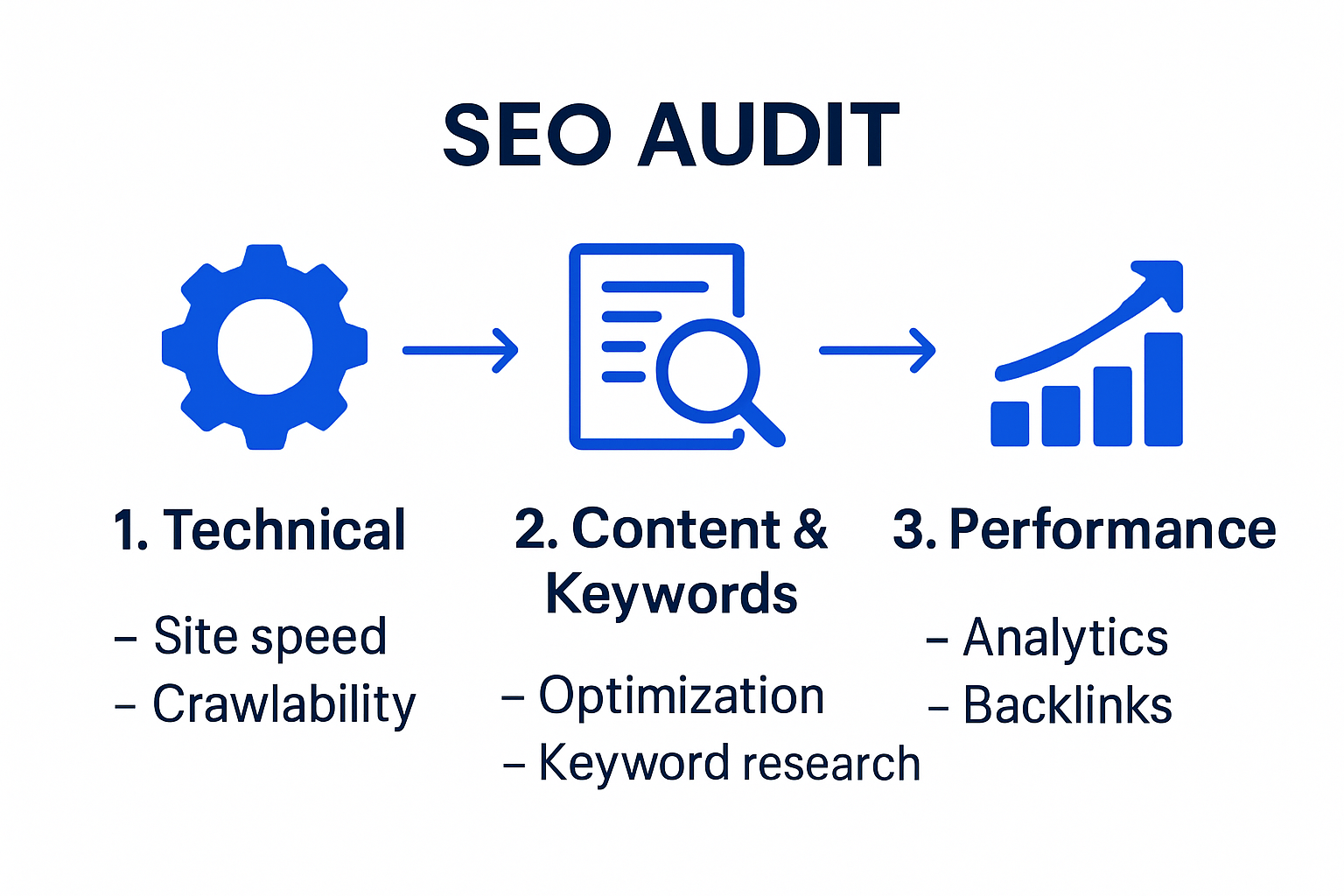Every website wants to rank higher on Google and stand out from the crowd. Even though most site owners believe they are following best practices, over 70 percent of websites have critical SEO errors that go unnoticed. Most guides focus only on keyword stuffing or backlink chasing, but real SEO wins actually come from a thorough technical and content audit. Get ready to discover what your site is really missing and why a true SEO audit is the game plan top sites rely on year after year.
Table of Contents
- SEO Audit Basics And Key Benefits
- Step-By-Step SEO Audit Checklist
- Common SEO Audit Tools And Methods
- Actionable Tips For Lasting SEO Success
Quick Summary
| Takeaway | Explanation |
|---|---|
| Conduct Regular SEO Audits | Routine audits uncover technical and content issues, enhancing your website’s search performance. |
| Optimize Technical Foundations | Ensure HTTPS, mobile responsiveness, and fast load times for better indexing and user experience. |
| Perform Content and Keyword Mapping | Identify relevant keywords and assess content quality to fill content gaps and enhance relevance. |
| Utilize Advanced SEO Tools | Leverage tools like Google Search Console and SEMrush to analyze performance and identify issues. |
| Focus on Continuous Improvement | Regularly update content and monitor performance to adapt to changing algorithms and user needs. |
SEO Audit Basics and Key Benefits
Performing an SEO audit represents a critical diagnostic process for websites seeking to optimize their search engine performance. Comprehensive website analysis allows businesses to uncover hidden opportunities and address potential barriers preventing optimal search rankings.
Understanding SEO Audit Fundamentals
An SEO audit is a systematic evaluation of all factors impacting a website’s search engine visibility. According to the American Marketing Association, this process involves an in-depth review of multiple website elements that directly influence search engine results page (SERP) rankings.
The core objectives of an SEO audit include:
- Performance Assessment: Identifying technical and content-related issues affecting search visibility
- Competitive Analysis: Understanding how your website compares to industry competitors
- Strategic Optimization: Developing targeted improvements for better search engine performance
Strategic Benefits of Regular SEO Audits
Regular SEO audits provide substantial strategic advantages for digital marketing efforts. Top digital marketing experts emphasize that comprehensive audits unlock significant opportunities across multiple digital channels.
Businesses conducting consistent SEO audits can achieve several critical outcomes:
- Algorithm Adaptation: Stay ahead of evolving search engine algorithm updates
- Technical Performance: Identify and resolve website infrastructure challenges
- Content Strategy Refinement: Discover content gaps and optimization opportunities
Long-Term Impact of Strategic SEO Auditing
Beyond immediate technical fixes, SEO audits serve as a strategic roadmap for sustained digital growth. By systematically analyzing website performance, organizations can develop data-driven strategies that enhance organic search visibility, improve user experience, and drive meaningful business results.
Learn more about avoiding potential SEO pitfalls with our strategic content optimization guide.
Step-by-Step SEO Audit Checklist
Navigating the complexities of an SEO audit requires a systematic approach that covers multiple critical aspects of website performance. Search Engine Journal provides a comprehensive framework for conducting a thorough technical and content-based evaluation that can dramatically improve your website’s search engine visibility.
Technical Foundation Assessment
The first phase of an effective SEO audit focuses on establishing a robust technical foundation. Carnegie Higher Ed emphasizes the critical elements that form the backbone of website performance:
- Security Infrastructure: Verify HTTPS implementation and SSL certificate status
- Mobile Responsiveness: Ensure complete mobile compatibility across all devices
- Site Speed Optimization: Analyze and improve page loading times
- Crawlability: Check robots.txt and XML sitemap configurations
These technical elements create the essential framework for search engine crawlers to effectively index and understand your website’s structure and content.
Here is a summary checklist table to help ensure you cover the key steps in the technical foundation assessment phase of your SEO audit:
| Technical Element | What to Check | Status (Yes/No) |
|---|---|---|
| Security Infrastructure | HTTPS and SSL certificate in place | |
| Mobile Responsiveness | Site displays & functions on mobiles | |
| Site Speed Optimization | Page load times optimized | |
| Crawlability | robots.txt & XML sitemap configured |
Content and Keyword Optimization
Content represents the core of any successful SEO strategy. A meticulous audit requires deep analysis of existing content and keyword alignment. Websites must systematically evaluate:
- Keyword Relevance: Identify and map primary and secondary keywords
- Content Quality: Assess depth, uniqueness, and user value of existing content
- Meta Tag Analysis: Review and optimize title tags, meta descriptions, and header structures
To prevent potential content performance issues, learn more about avoiding keyword conflicts that could undermine your SEO efforts.
Comprehensive Performance Evaluation
The final stage of an SEO audit involves a holistic performance review. SEO for Schools recommends a multi-dimensional approach that goes beyond surface-level metrics:
- Backlink Profile: Analyze quality and quantity of external links
- Competitor Benchmarking: Compare performance against industry standards
- User Experience Metrics: Evaluate engagement rates, bounce rates, and conversion potential
By methodically addressing each of these audit components, websites can develop a strategic roadmap for sustained search engine optimization success. Remember that an SEO audit is not a one-time event but an ongoing process of continuous improvement and adaptation.

To clarify the three main stages of the SEO audit process, the following table breaks down each phase and its primary focus areas:
| Audit Stage | Main Focus Areas |
|---|---|
| Technical Foundation Assessment | Security, mobile, speed, crawlability |
| Content & Keyword Optimization | Keywords, content quality, meta tags |
| Comprehensive Performance Evaluation | Backlinks, competitor benchmarking, user experience |
Common SEO Audit Tools and Methods
Modern SEO audits leverage sophisticated tools and strategic methods to comprehensively analyze website performance. The American Marketing Association highlights a comprehensive 14-step approach that combines technological solutions with strategic insights to evaluate and improve search engine optimization.
Essential Technical Analysis Tools
Technical SEO auditing requires a suite of specialized tools designed to uncover complex website performance issues. The Digital Government Authority recommends focusing on key technical elements such as:
- Crawling Tools: Analyze website structure and identify technical barriers
- Performance Analyzers: Measure page speed and loading efficiency
- Mobile Compatibility Checkers: Verify responsive design across devices
- Security Verification Tools: Confirm SSL certificates and HTTPS protocols
Popular tools in this category include Google Search Console, SEMrush, Ahrefs, and Screaming Frog, which provide comprehensive insights into website technical performance.
Content and Keyword Optimization Methods
Effective SEO audits go beyond technical assessments, diving deep into content quality and keyword strategy. Professionals utilize advanced methods to:
- Keyword Mapping: Identify content gaps and optimization opportunities
- Content Quality Assessment: Evaluate relevance, depth, and user engagement
- Competitive Content Analysis: Compare content performance against industry benchmarks
Discover advanced strategies for preventing keyword conflicts that can undermine your SEO efforts and dilute content performance.
Comprehensive Performance Evaluation Techniques
Georgia State University’s Communications Toolkit emphasizes a holistic approach to SEO auditing that incorporates multiple evaluation techniques:
- Competitive Benchmarking: Compare website performance against industry standards
- User Experience Metrics: Analyze engagement rates, bounce rates, and conversion potential
- Backlink Profile Assessment: Evaluate the quality and quantity of external links
Successful SEO audits require a multifaceted approach that combines technological tools, strategic analysis, and continuous monitoring. By implementing these methods, websites can develop a robust optimization strategy that adapts to evolving search engine algorithms and user expectations.
Actionable Tips for Lasting SEO Success
Achieving sustainable SEO success requires a strategic and holistic approach that goes beyond simple technical optimization. Government SEO Guidelines emphasize the importance of creating a comprehensive strategy that balances technical precision with user-focused content development.
Optimizing On-Page SEO Elements
Successful SEO implementation starts with meticulous on-page optimization. The SEO Project recommends a detailed approach to structuring website elements for maximum search engine visibility:
- URL Structure: Create concise, descriptive URLs that clearly communicate page content
- Title Tag Optimization: Craft compelling, keyword-rich title tags that accurately represent page topics
- Meta Description Strategy: Develop engaging meta descriptions that improve click-through rates
- Header Hierarchy: Use clear H1-H6 headings to organize content logically
These foundational elements provide search engines with clear signals about your content’s relevance and structure.
Security and Technical Performance
Website security has become a critical component of SEO success. Content Hurricane highlights the importance of implementing robust security measures that simultaneously protect users and improve search rankings:
- HTTPS Implementation: Secure your website with encryption to protect user data
- Page Speed Optimization: Minimize loading times across all devices
- Mobile Responsiveness: Ensure seamless performance on smartphones and tablets
Learn strategies to prevent content performance issues that could potentially undermine your SEO efforts.
Continuous Improvement and Monitoring
SEO is an ongoing process that requires consistent attention and adaptation. Successful websites implement a continuous improvement strategy that includes:
- Regular Content Audits: Periodically review and update existing content
- Performance Tracking: Monitor key metrics and search engine rankings
- Competitive Analysis: Stay informed about industry trends and competitor strategies
- User Experience Focus: Prioritize content that genuinely serves user needs
By adopting a proactive and comprehensive approach to SEO, websites can build a robust online presence that adapts to evolving search engine algorithms and user expectations. Remember that sustainable SEO success is about creating value for users while maintaining technical excellence.

Frequently Asked Questions
What is an SEO audit?
An SEO audit is a comprehensive evaluation of a website to assess its performance and identify technical and content-related issues that may affect its visibility in search engine results.
Why are regular SEO audits important?
Regular SEO audits help uncover hidden opportunities, address technical problems, and ensure your website adapts to changing search engine algorithms, ultimately improving search rankings and user experience.
How can I conduct a technical SEO audit?
To conduct a technical SEO audit, assess key elements such as website security (HTTPS), mobile responsiveness, site speed, and crawlability, ensuring that each component is optimized for search engine indexing.
What tools can I use for an SEO audit?
Popular tools for SEO audits include Google Search Console, SEMrush, Ahrefs, and Screaming Frog. These tools help analyze website performance, identify issues, and track improvements over time.
Solve the Hidden Keyword Overlap Holding Back Your SEO Audit Success
You have just learned how critical it is to spot technical barriers and content blockers during your SEO audit. But even well-optimized sites hit a wall when keyword cannibalization quietly undermines your hard work. Are you tired of seeing confusing rankings or flat organic growth after every audit? The article explained the pain of missed opportunities like content gaps and keyword conflicts. These are the silent killers that even seasoned consultants and agencies struggle to find without the right tool.
Take the next step and unlock your website’s full ranking potential with the #1 keyword cannibalization checker trusted by SEO experts. See keyword confusion before it damages your results. Start using the powerful Keyword Cannibalization Tool today to quickly identify and fix overlapping content issues. For an in-depth understanding of why keyword cannibalization matters and how to resolve it effectively, check out our dedicated guide on how to avoid keyword cannibalization. Visit https://rankaligner.com now to reveal what your audits have been missing and make every optimization count this year.
Recommended

